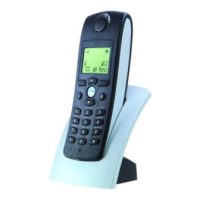AMT/PTD/PBX/0020/2/4/EN 01/2007 Page 165
• PARI VALUE: 9 digits maximum (the PARI number can be found on the PBX approval label).
• RANDOM VAL RECORDED and RS VAL RECORDED: maximum 9 digits.
2 random values (must not be the same) registered in the mobile by the PBX when the mobile
was registered on the DECT network. From this point onwards, the PBX regularly checks the
values registered in the mobiles (the values are calculated from these two parameters) in
order to authorise or refuse use of the DECT network.
Enter a value lower than 4294967295 (FFFF FFFFh). The value of the random number has
no significance. However, in a multi-site configuration the number must be identical in all
locations where the mobiles are to be registered.
• DIR. BEGINNING ASSIGNED TO LLP: 4 digits maximum, 999 is the default.
The base stations are connected to the PBX via an S0 Basic Rate Interface. One PLL (D
channel) is used for signalling and downloading to the base stations. PLL directory numbers
are comprised of digits recorded in this parameter followed by the base station declaration
order number.
Example: 999000, 999001, 999002, etc.
• CLOCK SYNCHRO: this line is used to configure the synchronisation of DECT clocks.
3 options, "Priority master", "Not priority master", "Slave".
• Case of a mono-site configuration : the default value for a site is "Priority master" (the
site is assumed to be autonomous).
• Case of a multi-site configuration : in simpex mode, only one PBX is configured in
"priority master" mode and provides the DECT synchronisation signal to the entire multi-
sites network. Other PBXs are configured in "slave" mode. In Duplex mode, there are
two "master" PBXs (one PBX is configured in "priority master" and the other in "not
priority master" mode) and they can provide the DECT synchronisation signal to the
entire multi-sites network. Other PBXs are configured in "slave" mode (see Chapter 11
for a multi-site configuration in simplex and duplex mode).
• CURRENT STATE: Read-only line indicating the current state of the DECT synchronization.
The possible states are : "TRANSMITTER", "TRANSMITTER NETWK CLK",
"TRANSMITTER LOCAL CLK", "RECEIVER", "RECEIVER NOT OK", "RECEIVER
POLARITY OK", "RECEIVER POLARITY NOT OK". It is thus possible to know:
• whether the clock is taken from the network or the local clock,
• whether a slave site takes its synchronization from the master or if It has become
transmitteur due to a link problem with the master,
• whether the cable polarisation is correct.

